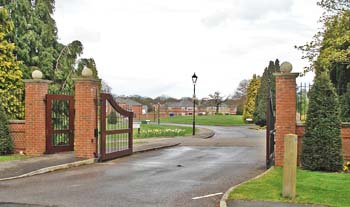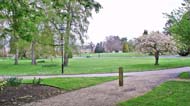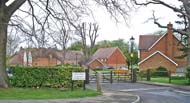Warlingham Park Hospital
Harrow Road, Chelsham, Nr Warlingham, Surrey CR3 9YR
Medical dates:
Medical character:
Mental
In 1889 Croydon was made a
County Borough under the London Government Act, 1888. One of its
new obligations was the provision of an asylum for its pauper lunatics.
Until the asylum could be built, an arrangement was made with the
LCC Asylum at Cane Hill to
continue to send its patients there. One-eighth of the beds at
Cane Hill were made available for Croydon patients for a 5-year period
(although this probably continued much longer), and the Cane Hill
Asylum was renamed the "London County Council Asylum with provision for
Croydon".
In 1894 a large site was purchased at Chelsham, about a mile northeast of the centre of Warlingham and, in 1897, architects appointed. The plans were approved by the Home Secretary and work finally began on the new asylum. It would cost about £200,000.
The Croydon Borough Asylum opened on 26th June 1903, but in the following year, on 21st April 1904, the Home Secretary sanctioned the name to be changed to Croydon Mental Hospital, on the suggestion of Dr Edwin S. Pasmore (1866-1927), the first Medical Superintendent. With this change of name, the Hospital received up-to-date equipment that would be found in any general hospital, for example, an operating theatre and an X-ray apparatus.
In 1910 three ward blocks were added at the cost of £33,000. One of the wards was equipped as an acute ward for physically sick patients. The Hospital then had 650 beds.
In 1926 the Hospital's proportion of recoveries to admission was about 68% - the highest in England and Wales. The death rate was about 7%.
By 1927 the Hospital had 656 patients, of whom 206 were men and 450 women (these was usually a higher ratio of women to men in all mental hospitals). All but 114 of these were rate-aided.
In 1927 Dr Pasmore died and was replaced by Dr Thomas Percy Rees, who had previously worked at Napsbury Hospital. Dr Rees acted as Deputy Physician Superintendent until he was appointed Medical Superintendent in 1935. One of his first acts in his new role was to open the iron gates by the Hospital entrance (after which they were never closed again). Over the subsequent years, all the ward doors remained unlocked during the day and almost all restraint and isolation of patients was abolished (by 1950 some 21 of the 23 wards were unlocked).
In 1937 the Hospital was renamed Warlingham Park Hospital.
In 1941 the first operation for pre-frontal leucotomy in the country was performed at the Hospital.
In 1948 the Hospital joined the NHS under the control of Warlingham Park Hospital Management Committee, part of the South West Metropolitan Regional Hospital Board.
The increase in the number of admissions following WW2 had led to severe overcrowding at all long-stay mental institutions, and Dr Rees began to consider establishing a psychiatric nursing service within the community to relieve the pressure on hospital beds.
In July 1954 two 'out-patient' nurses (as they were originally known - they were later renamed community psychiatric nurses) were appointed to provide support to discharged patients living in the community, as well as to give advice in Out-Patient Departments and therapeutic social clubs. The nurses also helped patients to find jobs and accommodation. Each had a caseload of 20 to 30 which constituted their 'ward'. A regular weekly 'ward-round' was held with a consultant psychiatrist.
A Social Centre for the patients opened in 1957. It contained a shop, a hairdresser, a cafe, a discussion room, a library and an office for the full-time chaplain. In the same year the BBC broadcast The Hurt Mind, it first television documentary on mental health. The Hospital features in the first episode 'Put Away'.
In 1964 the Hospital came under the control of the Croydon and Warlingham Park Group Hospital Management Committee, part of the South West Metropolitan Regional Hospital Board.
An Arts Centre was opened in 1964 by Lord Normanby and, in 1965, a Bowling Club was established, affiliated to the English Bowling Association and the Surrey Association.
Twenty acres of the Hospital's enormous grounds were cultivated by five gardeners.
In 1966, when the Hospital had 917 beds, one of the male wards was described by King's Fund visitors as vast, bleak and sparsely furnished. The ward contained 50-60 beds, so closely packed together that it was barely possible to stand between them. Three male nurses looked after the patients during the day and one at night. The female ward visited was described as being better and less crowded (although the visitors only saw the Admission ward, not a chronic one). The Recreation Hall had no stage, and its polished wood floor had been pitted by stiletto heels).
In 1966 an Industrial Therapy Department was established, where the patients could work for local firms, such as an electric shop. Chelsham House, the original residence of the Medical Superintendent, was converted into accommodation for residential medical staff, with an apartment for a married couple and 8 single rooms.
In October 1966 the chapel burned down. It was completely destroyed except for the stonework. At the time it was being redecorated and restored with financial help from the King's Fund.
In 1974, following a major reorganisation of the NHS, the Hospital came under the administration of the Croydon District Health Authority, part of the South West Thames Regional Health Authority.
By 1990 the Hospital had 407 beds.
It closed in February 1999.
Present status (April 2008)
Most of the Hospital buildings were demolished in 2000. Only the Grade II listed water tower survives.
The Hospital site is now Great Park, a large gated development of new housing.
In 1894 a large site was purchased at Chelsham, about a mile northeast of the centre of Warlingham and, in 1897, architects appointed. The plans were approved by the Home Secretary and work finally began on the new asylum. It would cost about £200,000.
The Croydon Borough Asylum opened on 26th June 1903, but in the following year, on 21st April 1904, the Home Secretary sanctioned the name to be changed to Croydon Mental Hospital, on the suggestion of Dr Edwin S. Pasmore (1866-1927), the first Medical Superintendent. With this change of name, the Hospital received up-to-date equipment that would be found in any general hospital, for example, an operating theatre and an X-ray apparatus.
In 1910 three ward blocks were added at the cost of £33,000. One of the wards was equipped as an acute ward for physically sick patients. The Hospital then had 650 beds.
In 1926 the Hospital's proportion of recoveries to admission was about 68% - the highest in England and Wales. The death rate was about 7%.
By 1927 the Hospital had 656 patients, of whom 206 were men and 450 women (these was usually a higher ratio of women to men in all mental hospitals). All but 114 of these were rate-aided.
In 1927 Dr Pasmore died and was replaced by Dr Thomas Percy Rees, who had previously worked at Napsbury Hospital. Dr Rees acted as Deputy Physician Superintendent until he was appointed Medical Superintendent in 1935. One of his first acts in his new role was to open the iron gates by the Hospital entrance (after which they were never closed again). Over the subsequent years, all the ward doors remained unlocked during the day and almost all restraint and isolation of patients was abolished (by 1950 some 21 of the 23 wards were unlocked).
In 1937 the Hospital was renamed Warlingham Park Hospital.
In 1941 the first operation for pre-frontal leucotomy in the country was performed at the Hospital.
In 1948 the Hospital joined the NHS under the control of Warlingham Park Hospital Management Committee, part of the South West Metropolitan Regional Hospital Board.
The increase in the number of admissions following WW2 had led to severe overcrowding at all long-stay mental institutions, and Dr Rees began to consider establishing a psychiatric nursing service within the community to relieve the pressure on hospital beds.
In July 1954 two 'out-patient' nurses (as they were originally known - they were later renamed community psychiatric nurses) were appointed to provide support to discharged patients living in the community, as well as to give advice in Out-Patient Departments and therapeutic social clubs. The nurses also helped patients to find jobs and accommodation. Each had a caseload of 20 to 30 which constituted their 'ward'. A regular weekly 'ward-round' was held with a consultant psychiatrist.
A Social Centre for the patients opened in 1957. It contained a shop, a hairdresser, a cafe, a discussion room, a library and an office for the full-time chaplain. In the same year the BBC broadcast The Hurt Mind, it first television documentary on mental health. The Hospital features in the first episode 'Put Away'.
In 1964 the Hospital came under the control of the Croydon and Warlingham Park Group Hospital Management Committee, part of the South West Metropolitan Regional Hospital Board.
An Arts Centre was opened in 1964 by Lord Normanby and, in 1965, a Bowling Club was established, affiliated to the English Bowling Association and the Surrey Association.
Twenty acres of the Hospital's enormous grounds were cultivated by five gardeners.
In 1966, when the Hospital had 917 beds, one of the male wards was described by King's Fund visitors as vast, bleak and sparsely furnished. The ward contained 50-60 beds, so closely packed together that it was barely possible to stand between them. Three male nurses looked after the patients during the day and one at night. The female ward visited was described as being better and less crowded (although the visitors only saw the Admission ward, not a chronic one). The Recreation Hall had no stage, and its polished wood floor had been pitted by stiletto heels).
In 1966 an Industrial Therapy Department was established, where the patients could work for local firms, such as an electric shop. Chelsham House, the original residence of the Medical Superintendent, was converted into accommodation for residential medical staff, with an apartment for a married couple and 8 single rooms.
In October 1966 the chapel burned down. It was completely destroyed except for the stonework. At the time it was being redecorated and restored with financial help from the King's Fund.
In 1974, following a major reorganisation of the NHS, the Hospital came under the administration of the Croydon District Health Authority, part of the South West Thames Regional Health Authority.
By 1990 the Hospital had 407 beds.
It closed in February 1999.
Present status (April 2008)
Most of the Hospital buildings were demolished in 2000. Only the Grade II listed water tower survives.
The Hospital site is now Great Park, a large gated development of new housing.

The entrance gateway to Great Park.


New housing and parkland on the former Hospital site.

Parkside Mews, to the west of Great Park.
(Author unstated) 1951 Mental patients saved by brain operation. Tenth anniversary of new technique. British Journal of Nursing (June), 59.
Chaplin R, Peters S 2003 Executives have taken over the asylum: the fate of 71 psychiatric hospitals. Psychiatric Bulletin 27, 227-229.
http://warlinghamparkbowls.btck.co.uk
www.bethlemheritage.org.uk
www.britishlistedbuildings.co.uk
www.countyasylums.com
www.exploringsurreyspast.org.uk
www.flickr.com
www.geograph.org.uk (1)
www.geograph.org.uk (2)
www.geograph.org.uk (3)
www.ncbi.nlm.nih.gov
www.nursing.manchester.ac.uk (p.10)
www.studymore.org.uk
Return to home page